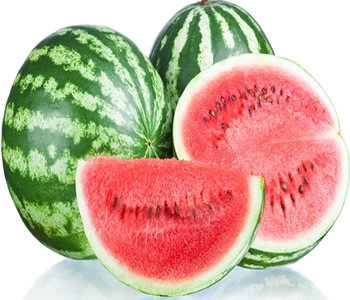
ABOUT WATERMELON
FRESH watermelon, scientifically called Citrullus lanatus, is loosely considered a type of melon though not part of the genus Cucumis. It has a smooth exterior rind ranging from green, yellow and sometimes white juicy, sweet, mostly red, but at-times orange, yellow, or pink interior flesh.
There are more than 1,200 varieties of watermelon ranging in size from less than a pound, to more than 200 pounds with flesh that is red, orange, yellow, or white.
Several notable varieties are: Densuke watermelon, which has round fruit up to 11 kilogrammes. The rind is black with no stripes or spots. It is only grown on the lsland of Hokkaido, Japan, where up to 10 000 watermelon are produced each year and eaten in a variety of ways and is also often used to flavor summer drinks and smoothies.
Carolina cross is a variety of watermelon that produced the current world record watermelon weighing 262 pounds. It has green skin, red flesh and commonly produces fruit between 65 and 150 pounds.
The yellow crimson watermelon is a variety of watermelon that has a yellow coloured flesh. It has been described as "sweeter" and more "honey" flavoured than the more popular red flesh watermelon.
Watermelon contains about 6 per cent sugar and 92 per cent water by weight. As with many other fruits, it is a source of vitamin C. It is not a significant source of other vitamins and minerals unless one eats several kilogrammes per day.
The amino acid citrulline was first extracted from watermelon and analysed. Watermelons contain a significant amount of citrulline and after consumption of several kilogrammes, an elevated concentration is measured in the blood plasma, this could be mistaken for citrullinaemia or other urea cycle disorder.
Watermelon rinds are also edible, and sometimes used as a vegetable. In China, they are stir-fried, stewed, or more often pickled. When stir-fried, the de-skinned and de-fruited rind is cooked with olive oil, garlic, chilli peppers, scallions, sugar and rum.
Pickled watermelon rind is also commonly consumed in the Southern U.S, Russia, Ukraine, Romania and Bulgaria. In the Balkans, especially Serbia, watermelon slatko is also popular. Watermelon is also mildly diuretic. Watermelons contain large amounts of betacarotene.
Watermelon with red flesh is a significant source of lycopene.
Watermelon seeds are excellent sources of protein and oil. Watermelon seed is about 35 per cent protein, 50 per cent oil, and 5 per cent dietary fibre. Watermelon seed is also rich in micro- and macro-nutrients such as magnesium, calcium, potassium, iron, phosphorous, zinc etc.
Return to Galleria Health & Lifestyle Nigerian Dishes Recipe Index




